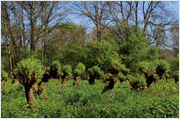The world before plasticback
 Tel: 02173-99986-134
Tel: 02173-99986-134
This is the last basket willow plantation to survive in the Urdenbacher Kämpe. Looking at the trees it is hard to see that they once provided the raw material for a whole local industry. But their name gives it away: the thin and flexible withies were used for basket weaving. Fruit was an important cash crop in the fertile wetlands. But without basket willows – also known as osiers – it would have been difficult to market. How to get the fruit to the consumers? Nowadays we use Ifco trays or plastic bags. But only fifty years ago, willow baskets were the fruit containers of choice. Their durability and good ventilation makes them ideal for transporting large amounts of fruit. Damage is rare and easy to repair, not least because the necessary material literally grows on trees all around. Regional characteristics determine which crops are grown, that much is obvious, but who would have thought that landscape features also influence the transport and storage of agricultural products? But the local basket weavers were unable to compete with modern materials and marketing methods. The traditional craft disappeared when the last basket weaver in Baumberg died in the 1990s. This basket willow plantation is used to show children where the raw material for baskets came from. In learning about basket weaving, they also learn about all the useful things the wetlands provide.
Photo: Joschka Meiburgback






